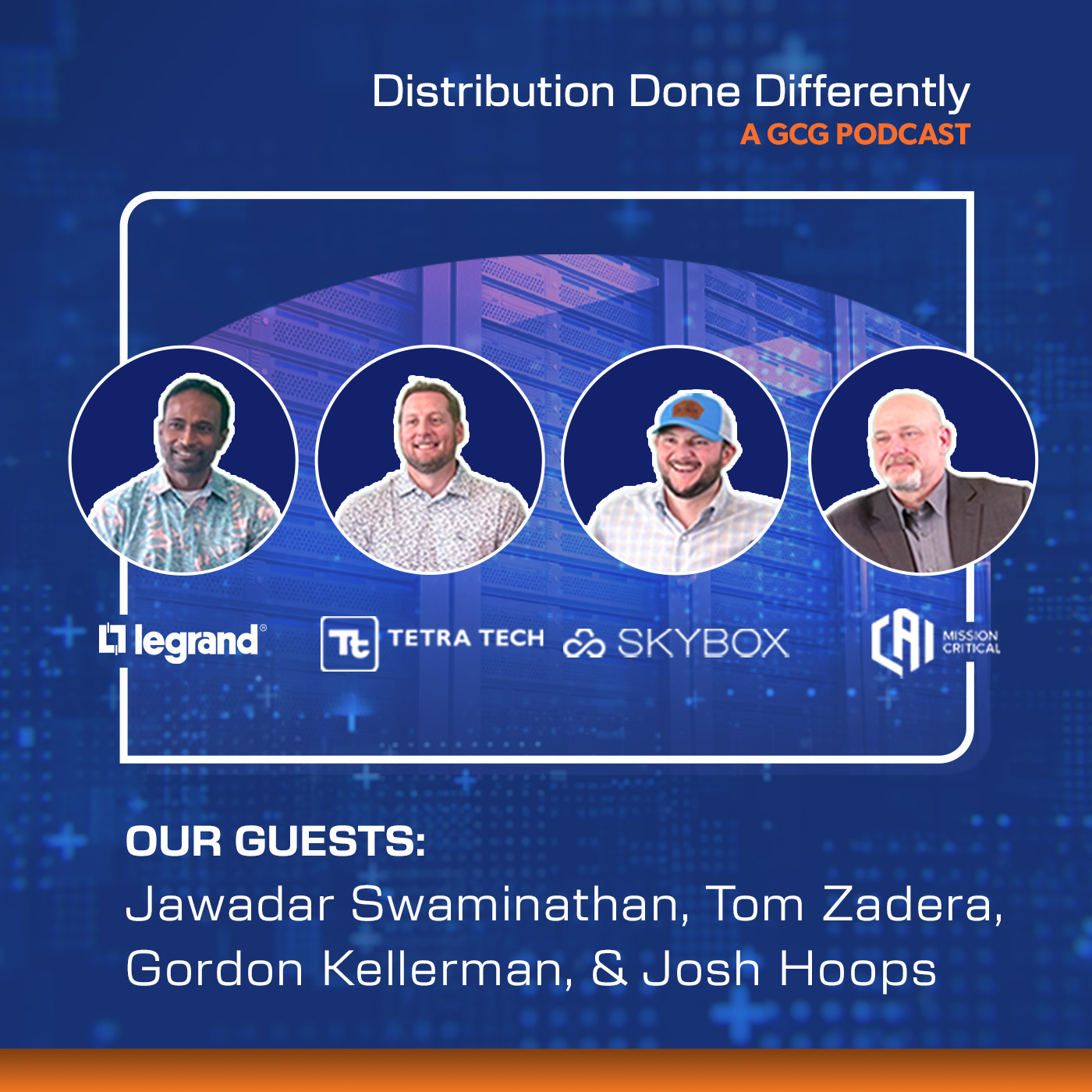LISTEN NOW
 Episode Two
Episode Two
Shaping the Future: Insights and Predictions
SPONSORED BY: LEGRAND

Welcome to the second episode of “Distribution Done Differently.” In this exciting installment titled “Shaping the Future: Insights and Predictions”, we look back at and summarize conversations we had with industry thought leaders during PTC 2025. Hear what thought-provoking industry leaders from Legrand, Tetra Tech, CAI Mission Critical, and Skybox Datacenters had to say.
Pivotal trends that are set to redefine data center strategies and operations in 2025 were explored. From the innovative use of liquid cooling systems to the evolution of power supply solutions and the transformative impact of artificial intelligence, this episode promises to deliver valuable insights that will equip you with the knowledge to stay ahead in the rapidly changing landscape of data technology.
Episode Transcript
Disclaimer: This transcript is from a live panel conversation during a luncheon at PTC25. the audio file is not an exact match to this transcript. The transcript was used to create the audio file summary.
Chrissy Olsen: Hello, everyone, and welcome to the very first episode of Distribution Done Differently, a podcast that leads conversations with industry leaders exploring trending topics and addressing challenges in the data center market.
We are excited to launch episode number one, Shaping the Future, Insights and Predictions from Data Center Industry Leaders, sponsored by our vendor partner, Legrand.
I’m your host Chrissy Olsen, VP of Sales GCG Data Center. Today I’m joined by some great industry thought leaders from Legrand, Skybox Datacenters, TetraTech and CAI Mission Critical. I'm going to go ahead and let the panelists introduce themselves.
Gordon Kellerman: Hey, Chrissy. Gordon Kellerman with Skybox Datacenters, VP of Sales. Very excited to be here to talk about Lessons Learned.
Josh Hoops: Josh Hoops. I'm the Global Vice President of CAI Mission Critical. I've been with the company for about six years. Prior to that, I did a short stint of 27 years in the Navy, and now I'm applying my Naval experience to basically submarines on land, so it's pretty awesome. Really excited to be here. At CAI Mission Critical, we focus on the commissioning aspect of data centers, so that's where we live in that space, and I'd be happy to talk more about that.
Tom Zadera: My name is Tom Zadera. I'm with Tetra Tech. Tetra Tech's a global consulting engineering firm. I'm the Vice President. I lead our Mission Critical team here in the United States. We are a full-scale A&E firm. We have locations around the world with approximately 30,000 engineers Within our High Performance Buildings group, which focuses on our Mission Critical, our technology group, has around 4,000 engineers that are really looking to design data centers of the future and focus on AI-level data centers.
Jawadar Swaminathan: Hello, everybody. My name is Jawadar Swaminathan. I'm with Legrand, and I'm the Senior Director of Product Management for the data connectivity side of the business. We are in data centers quite a bit. You might recognize our names, like Starline, Server Technology, or Ortronics, if you go far back a few years. So that's the business line we're in. Personally, I've been in the data center industry for about 25 years.
Chrissy Olsen: Let’s dive right in. Looking back on 2024, what was the most impactful event or trend in your business, and how did it shape your strategies and operations? Want to go first Tom?
Tom Zadera: Yes. Sure. Thank you. I think the biggest thing that we noticed in 2024 was the shift in percentage of liquid cooling type designs.
I think going into 2024, air-cooled solutions are really the dominant percentage of builds that we see across the country and across the globe.
When people first started to put their AI GPU loads in, I think that the boom has really taken off to where now we're seeing percentages of liquid cooling be 75% to 80% of the total design.
That was a very fast change that we're seeing many folks make, and it's creating a very dynamic situation for what power and cooling requirements will be changing over the course of the next few years.
We're really excited about what 2025 is going to hold, and I think we're going to see a lot of changes in what the Rackspace infrastructure looks like.
Jawadar Swaminathan: I agree.
We see a lot of that in our business as well. If you look at just the Legrand side, for our company, we made a big bet in 2022. This is around connectivity first, but without really recognizing what's coming ahead.
We couldn't see the future, and we saw AI happen or blow up in 2023. The product that we came up with just helped speed up data center deployment on the connectivity side.
Once everything goes into the Rackspace, how quickly can you bring these services and network switches up and running?
It was a good combination of right timing, as well as having the right product. That was 24 plus, pretty much.
We're really excited about 2025, what it holds, and to seize the opportunity that AI brings.
Gordon Kellerman: I think to build off of that, just the sheer densities and us increasing and trying to sustain these new video chips.
It's absolutely insane. What we used to do over a couple million square feet is being done over a couple hundred thousand square feet. As Tom mentioned, none of that's done without liquid cooling.
There's no way for us to continue to pull these densities out. We're not using any other kind of software other than the chip. That's definitely been probably the biggest impact on our businesses, how many megawatts can be consumed in X amount of square feet.
Operationally, we've had to scale accordingly. We've got to bring in additional techs. A lot of the Navy folks tend to be very good candidates for those positions.
On the connectivity side, being able to see new latencies, taking a lot of this compute out of the core. Putting it back into rural communities or areas where you can actually access large-scale power to train these language models.
Then being able to distribute content closer to the core. I think you've seen an evolved hub-and-spoke model for the last 12, 24 months from hyperscalers where content stays close to people. We're putting a lot of compute where it should be.
Josh Hoops: What they said. So I'm going to take it from a little bit of a different perspective. How many people here are familiar with commissioning itself?
Okay, good. I always have to ask that question because some people are like, I have no idea what it is you guys do. Yes, all of that, what they said, has been a significant shift for us.
But we look at it more from how does it impact everything from, so as a professional services firm, our product is our people.
And this is all new stuff, right? And as a commissioning firm, we have to go out and be the experts in full-scale testing of all of these facilities.
So when new systems come online, we really have to think outside the box and say, okay, what is it that we really need to test and efficiently? As everybody in this room knows, speed is paramount, and we always get the short end of the stick on the whole process because we're the last piece before it gets turned over to have all the servers and everything installed.
So we really, in 2024, stepped up our game in trying to get our teams up to speed with all the changes that are coming.
I'll talk a little bit more about that when we talk about 2025, but that's really what our focus was in 2024, was zeroing in on what the technical competencies of our team is going to have to be as we move forward with this rapid escalation, particularly with the liquid cooling and submersible cooling and things like that.
Chrissy Olsen: Great. So I'm going to add to this, too, because it's my show.
But the most impactful thing for me was obviously starting at GCG, Ground Floor Data Center Distribution Business Unit. Anything from the ground floor in the data center space is difficult, but it's been a fantastic ride. I have a fantastic team.
And I would say working with the vendors and getting those partnerships established was probably the most impactful thing so far in the business.
Okay, so going on to 2025. As we move into 2025, what trends do you foresee or predict? And we talked a little bit on this in the last one.
That's going to change the industry. And how are you prepping for those?
Gordon Kellerman: I think for 2025, the trend of bringing your own power plant to sustain these data centers is going to become mainstream.
We've seen just how, I guess, impactful or fragile a grid may be with our existing assets in order to take any net new load or take behind the meters just not going to be acceptable.
You've seen some of the pushback for the talent deal in Pennsylvania, and I think you'll see more of that regulatory pushback for anything that is an existing asset.
But with that said, the United States is in a massive energy transition. We all are big advocates of Small Nuclear Reactors also know as SMRs, but we realize the timeframe is just not quite there yet. We're probably five, seven years away from actionable, cost-effective SMRs.
And in the interim, we're going to need baseload to sustain all the data center growth. And so you'll see a lot more natural gas plants with the ability to get converted to green hydrogen. So there's going to be a really great sustainability story there.
I think we're all going to have to kind of collectively come together at the table to figure out how that process unfolds. But really for 2025, the scale is not going anywhere. The demand is there, and we're going to have to be doing our part to be part of that power solution as well.
Josh Hoops: Yeah, so a lot of the lessons learned that we took from 2024 and thinking about investing in the future.
And again, I'm going to go back to the people part. So we have to figure out a way collectively to be more efficient in getting the data centers up and operating.
And I mean, that can be a topic probably all on its own. But one of the things I think is going to be a big factor in that going forward is using AI as part of our processes.
So we are, and obviously this isn't a commercial for CAI, but we're investing a significant amount of money in figuring out how do we use AI to shorten our processes and make it more efficient.
What we do in the entire build process of a data center is so manual and labor some and time-consuming.
And we have to figure out a way to use the systems that we're building to be able to make ourselves more efficient. And so there's, again, that can be another topic all on its own.
But that's something that I think we're really going to make as an industry some big strides on that people are willing to commit. And figure out what the right answer is.
And it's adopted. I think one of the biggest issues we're going to have is, hey, my team, we can come up with all kinds of great ideas and implement.
But at the end of the day, if you guys aren't willing to adopt what we're putting together, it's just going to be the same thing over and over again.
Definition of insanity. I really think that this is going to be a big push going from our perspective in the entire commissioning spectrum through 2025 and beyond.
Tom Zadera: Yeah, I want to echo a lot of what Gordon and Josh said there. I think the bring your own power model is something that we're starting to see more and more of. I think that the impatience of a lot of the biggest firms are not willing to wait years for substation or utility-based power to be connected to new land sites.
And so we have been working on multiple projects that have very interesting components to them. Folks are looking at totally off-grid solutions in areas where they can buy cheap land in large quantities and do a mixture of natural gas generation and doing solar and doing some wind, all in the hopes to then maybe charge a large-scale battery energy storage system.
And so these are a lot of components that we haven't seen in your basic data center development. And so I think those are technologies that are going to bridge us into the next phase of this, which is nuclear power.
And so that's what I think is most exciting for our firm is the 1,400 nuclear engineers that we have on our staff that are very, very excited about the ability to get a permit through the process of the Nuclear Regulatory Commission.
And so I do think that based on the latest sort of hot-off-the-press executive order or memorandum that went out from the White House last week, I think we're all trying to understand what the impacts of that's going to be, outlining data center development on federal lands, on DOD and DOE property.
What does that mean? How fast is this project going to come about? How much regulation is going to be cut in that process? I think we can all agree that sustainable, clean power is what is necessary for the advancement of this AI boom that we're all seeing.
And so finding that next project or being the first firm that can successfully get a permit for an SMR installation is something that we're really, really excited about.
And I think we might see that by the end of 2025.
Josh Hoops: I also want to add to that that I think there's going to be a big problem with nuclear with adoption still. Start with people in this industry, right?
We all know what nuclear could do for us. The general population does not.
There is a stigma that has to be overcome in order for the SMRs to really make progress. People in this industry can be sort of the jump off if we can somehow figure out a way to communicate that to the general population. I think that's going to be a key part of it.
Jawadar Swaminathan: Well, I will change the context a little bit because at Legrand we come into play mostly after everything that you mentioned is already done, right? You figured out where to build it and how to energize it.
Then we come into the picture. When we come to the white space the challenge that we see is generally with how to scale. I don't think it's just relevant for the white space vendors, but it is relevant in general for the for the entire industry. I mean we were just dealing with Hyperscale and now we have
AI scale. The conventional thinking is about how fast you can build a data center? How much does it cost to build a data center? Where is a suitable place to build a data center? Everything must be challenged and we talked about nuclear power. Was that in the discussion 10 years back? I don't know.
I mean outside of the submarines. So that's something that we are really keeping an eye on and preparing ourselves to deal with. It's unprecedented like how fast the data center is growing and when we get those opportunities are we ready are we ready with the right products? Are we ready with the capacity? Can we turn around as quickly as possible? Internally as an organization we are challenging all the processes that we have in place and do we have the right products for this kind of scale and this kind of a deployment. So how do we simplify things? If we can simplify the deployment and accelerate the deployment time I think we can deliver the right product.
So that's where most of our focus has been and on the confluence of innovation that started a while back. We are ready. We're prepared with the capacity that's needed and the innovative products that we need but that's just uh from the white space perspective.
Chrissy Olsen: So I’m also going to come from a different perspective because GCG is a distributor. We should be in early in the discussions with all the people involved but sometimes we're not because the end users already said, okay, we're going to build here. We know how to power the data center and we want it tomorrow, right? So how do we from a distribution standpoint get ahead of that? I see supply chain management being a very important piece pre-provisioning product from the time that contract gets signed because there's certainly timelines that are extremely long. Some of them up to 52 weeks.
And then bringing it in all the product so that you can feed the project deployment upfront instead of always chasing the product. Your whole project is relying on delivery of product just to get even the gray space built. We've all been building so fast, moving so fast and growing so fast, but we have to work smarter when it comes to product.
Okay, so we talked a little bit about what you guys are excited by or what you're looking forward to. But what really excites you as you look ahead in this year either something you’re doing or building or changing in your business?
Jawadar Swaminathan: I will continue on the on the point I made earlier. We are coming from the product perspective. At Legrand we live and breathe products. We started thinking about how do we change? How we innovate?
What kind of products do we bring to market and how is it going to impact the market.
We looked at the change in scale and the change in pace that we are seeing in the buildouts. We looked at our operations as well. We took the approach of how is it going to simplify things for the customer?
But in the process if we can simplify our own operations maybe it's a win-win so we can meet the kind of product demands Chrissy talked about.
We don't have the luxury of planning when we receive the RFQ. It's kind of late already and everybody scrambles, so one of the ways we are trying to solve this is how we can rationalize our own product portfolio instead of having hundreds of models of something. Can we just bring it to a handful so that it is not confusing for somebody to pick products, you don't waste time on specs and it's not so hard for us to stock and maintain inventory. Planning is everything right? It is just one aspect of what we did on the on the innovation side from a product perspective.
When it comes to product, we're all used to cassettes in the data center and where fiber optic gets distributed. We just shrunk it. We went from 100
different models of cassettes to a simple adapter that you only have six versions of. The planning cycle is shorter, our production cycle is shorter, and inventory is plenty. So that's one of the ways we are solving challenges we see in in 2025. It's taking off and it's looking very good.
Tom Zadera: Awesome Yeah, I think you know, one of the things that's really exciting about this upcoming year is, you know Looking back at some of the
projects that we were involved in, you know Everyone's seen the big multi hundred megawatt or up to gigawatt size campuses really exciting stuff.
These are massive projects that require huge teams and the financing that's behind it Um, you know, I think everyone has recognized the amount of money and financing and capital that's coming to our business at the moment.
Which is really making data centers, you know mainstream news Um, so for a lot of us, you know, I was fortunate enough to join this industry about 18 years ago Um, you know living in northern Virginia watching, you know, the global internet coming grow up out of our backyard. And so, you know, looking at the size of the deployments now, so for every large-scale deployment, you know,
I'm also really excited about some of the folks that are thinking differently. And as an example, working with a client that's working exclusively with immersion cooling, using over 200 kilowatts per rack, and we're doing a megawatt inside of a thousand square feet. And so, with the 10x in power requirements, we're also seeing a reduction 10x in the floor space requirement. And so, folks are thinking very differently about how they're going to go to market. And so, I think it's really exciting to work with some of the smaller AI firms and some of these smarter groups that are, in a lot of ways, challenging the designs, and maybe that will then be the implemented design in the future. And so, yeah, there's a lot of really smart people out there that are looking at the set of challenges, opportunities, and really changing the game using technology in different ways. So, I think we're going to see vastly varying designs over the next 12 to 24 month period.
Gordon Kellerman: Yeah, totally agree with Tom. To kind of piggyback, I'd say, without a doubt, the density is continuing to increase. I think continued collaboration amongst all of us here is going to drive further innovation. You can only put so many breakers in so many positions. You can only remove so much heat from so much of the space, but one megawatt in a couple thousand square feet might be now three megawatts in 500 square feet. The capabilities are there, at least with the chip. We currently cannot cool that.
That's where the industry is going. And there's no way for us as a developer to stay in front of that without our partners and friends actually designing a better mousetrap. And just like you mentioned on the cassettes, standardizing, making it smaller, making it more efficient. It's all going to be things that we're going to need because with a lot more compute and a lot smaller area, it's a lot more fiber. It's a lot denser, but more things need to go in a smaller space.
So, we're all going to have to work together to design a better box.
Josh Hoops: You kind of stole my thunder with the collaboration. So, what really excites me is, particularly over the last six months, there's been a lot of discussion in our sector, I guess you would call it, the commissioning side of figuring out how all of us commissioning partners can collaborate to work together. So, I'll give you an example. If a client has a gigawatt data center they want to commission, there is not a single firm on this planet that can do it in the time frame that they're wanting it to be done. It's going to require a bunch of firms working together, which, as you can imagine, doesn't sound too pleasant because everybody's out for themselves, right? So, not really. I've had discussions with some of the biggest players in the industry on our side that they're ready. We're all ready. We're all ready to support, do whatever is necessary. And again, going back to the innovation piece, figuring out a way to do it faster, smarter, not so labor some.
So, I'm excited for the collaboration. I really do see it. It's just a matter of how do we do this, right? And that's just dotting the i's, crossing the t's, contractual language, all that kind of stuff, right? We can get through all that, but it really has to be a partnership. Our clients have come to us and said, hey, we know you can do it by yourself. We know that. So, we've got to figure out a way to solve this problem because, again, we get put on the short end of the stick,right? Everybody's waiting for commissioning to hand over the facility because they got to make money, right? So, that's what I'm excited for. All the innovation, everything that goes into everything that we do on our side, I think we're just at the beginning. I think it's just getting ready to explode. I'm ready.
Chrissy Olsen: Awesome. Thank you, guys.
And that's a wrap on today's episode. Thank you for tuning into Distribution Done Differently.
A huge thank you to each industry leader who participated in today's panel.
Josh Hoops from CAI Mission Critical, Gordon Kellerman from Skybox Datacenters, Jawadar Swaminathan from Legrand and Tom Zadera from Tetra Tech.
A big thank you to Legrand for sponsoring this episode. For more information about GCG or the Legrand product offering, check us out on our website gogcg.com, follow us on LinkedIn at GCG Data Centers or email us at connect@gogcg.com
MEET THE HOST
Chrissy Olsen, Data Center Innovation Leader
With over thirty years of experience in the technology and data center industry, her expertise in data center design, deployment, and operational efficiency makes her a key resource for enhancing industry practices globally.
Chrissy has spoken at numerous industry events worldwide and has received several awards for her contributions to the field. She is also a strong advocate for women in technology, actively participating in organizations like iMasons and Women in Tech.

Get Early Access to Upcoming Episodes:
Suggest a Podcast Topic
Is there a data center topic you're curious about? Click here to share it with us, and it might be featured in an upcoming episode of Distribution Done Differently.
Sponsor an Episode
Interested in sponsoring an episode of Distribution Done Differently? Let's connect and explore the possibilities
Request a Consultation
Need assistance with your data center project or want to explore GCG Data Center solutions? Connect with us.




